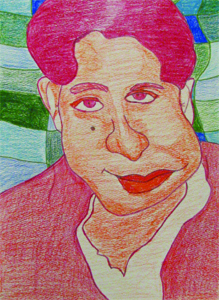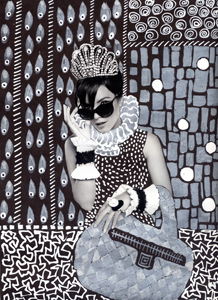
Professional
Resume
Lesson Plans
To inquire about additional Lesson Plans or to purchase Lesson Plans, please Contact Penelope.
 Stretching the Truth
Stretching the Truth
Distortion is no newcomer to the art world. Magritte, Munch, Disney animators, political cartoonists, and any number of other artists have stretched and distorted the human face. Along with these art forms, graphing in order to transfer images to larger or smaller sizes, is also a time honored tradition. This process is an ideal way to introduce a unit on portraiture that also encompasses drawing techniques, mathematical graphing and a great deal of imagination.
 Passion for Pattern
Passion for Pattern
Students study the work of Gustav Klimt in the context of the Vienna Seccesion Movement and contemporary issues of repatriation of Nazi confiscated art. Students will explore pattern and texture in a mixed media collage painting.
Philosophy of Teaching
It has always been my philosophy that visual arts should be taught, not for the few artistically gifted students, but for all students, to train their whole mind. Visual literacy is becoming more important with the major role technology plays in all our lives and visual arts classes should reflect that. My belief is that the teacher who can maintain passion and enthusiasm about the subject, has the greatest impact on enhancing the visual confidence in their students about visual literacy and artistic abilities.
The arts play a leading part in the economy of our state and our nation. To better prepare students to take their place in that economy, it has been my goal to help them learn those skills that the visual arts teach; those skills that will enable them to have viable careers in any field: active imaginations, creative problem solving abilities, drawing as a means of communicating, working successfully with a variety of tools and materials, and working well with other people as well as on their own.
Yes, visual art should be fun. It should help build confidence. But, it is also a tremendously important skill builder essential to creating life-long learners and producers. I believe in the ability of all students, with proper guidance and instruction, to improve their communication skills through the visual arts - not just the creating of it, but the discussing, reading, and writing about it. The teaching of visual arts needs to embrace cultural literacy, work with the hands as well as the mind, and create citizens who can think for themselves for the betterment of humanity.
Endeavoring to help every student be successful is a joy to me personally and professionally because it helps me continue to learn and grow through my students. A major player in maintaining passion and enthusiasm is professional associations. That is why CAEA and NAEA have been such an important part of my life. It has been my privilege to be part of the visual art education system for over 50 years and it is my hope that I may continue in some capacity for a good many more years to come.